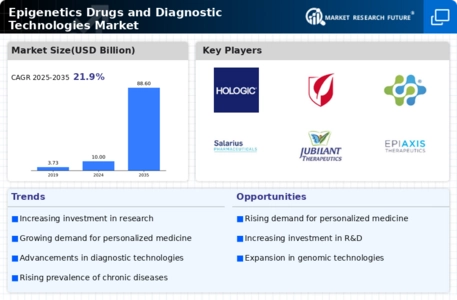By region, the study segments the market into North America, Europe, Asia-Pacific, and the rest of the world. North America epigenetics drugs and diagnostic technologies market held the largest market share in 2022, due to the rising incidences of chronic diseases and the presence of major and active players including Illumina, Inc. (US), Gilead Sciences, Inc. (US), Celleron Therapeutics (US), LISEN lmprinting Diagnostics (US), and Salarius Pharmaceuticals, Inc. (US).
Further, the major countries studied are: The US, Canada, Germany, France, the UK, Italy, Spain, China, Japan, India, Australia, South Korea, and Brazil.
FIGURE 3: EPIGENETICS DRUGS AND DIAGNOSTIC TECHNOLOGIES MARKET, BY REGION, 2022 & 2032 (USD BILLION)

Source: Secondary Research, Primary Research, Market Research Future Database and Analyst Review
Europe's epigenetics drugs and diagnostic technologies market accounted for the second-largest market share due to the rising prevalence of genetic disorders and the launch of epigenetic tests to detect genetic disorders. In March 2019, the European Commission revealed that there are approximately 5.2 million births in Europe each year, and nearly 2.5% of people are born with congenital anomalies, a type of Down syndrome. Moreover, in April 2019, at the London Health Science Centre, a genome-wide DNA methylation test developed by a Canadian team was launched in European clinical laboratories.
Furthermore, the Germany market of epigenetics drugs and diagnostic technologies held the largest market share in 2022, and the UK market of epigenetics drugs and diagnostic technologies is projected to be the fastest-growing market in the Europe region.
The Asia-Pacific epigenetics drugs and diagnostic technologies market is expected to grow at a significant rate from 2023 to 2032, owing to the growing incidence of neurological diseases and increasing collaboration for the development of the drugs. As per the Alzheimer’s Disease International revealed in 2020, there are higher chances of Alzheimer’s in developing countries including China, India, South Asia, and Western Pacific neighbors due to the fastest growth of the geriatric population.
Furthermore, in January 2021, Celleron Therapeutics (UK) partnered with Nuance Biotech Ltd. (China) in order to develop a next-generation epigenetic immune regulator to target histone deacetylase to kill cancer. Additionally, it received approval from the Chinese Center for Drug Evaluation for a clinical trial of an investigational new drug (IND) registrational trial to develop CXD101 in patients suffering from peripheral T-cell lymphoma (PTCL). Moreover, the China market of epigenetics drugs and diagnostic technologies accounted for the largest market share, and the India market of epigenetics drugs and diagnostic technologies is projected to be the fastest-growing market in the Asia-Pacific region.

















